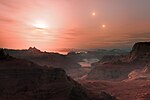| Observation data Epoch J2000 Equinox J2000 | |
|---|---|
| Constellation | Perseus |
| Right ascension | 02 42 58.21780 |
| Declination | +48° 55′ 48.2155″ |
| Characteristics | |
| Spectral type | K3III |
| Astrometry | |
| Radial velocity (Rv) | -5.60 ± 0.51 km/s |
| Proper motion (μ) | RA: -5.94 mas/yr Dec.: -2.02 mas/yr |
| Parallax (π) | 1.36 ± 1.13 mas |
| Distance | approx. 2,000 ly (approx. 700 pc) |
| Details | |
| Mass | 1.09±0.16 M☉ |
| Radius | 10.33±1.81 R☉ |
| Luminosity | 43.7 L☉ |
| Surface gravity (log g) | 2.48±0.04 cgs |
| Temperature | 4534±8 K |
| Metallicity | -0.13±0.06 dex |
| Rotational velocity (v sin i) | <2.9 km/s |
| Other designations | |
| BD+48 740, AG+48 308, GSC 03304-00090, HIC 12684, HIP 12684, 2MASS J02425822+4855483, PPM 45405, SAO 38272, TYC 3304-90-1 | |
| Database references | |
| SIMBAD | data |
BD+48 740 is a giant star suspected of having recently engulfed one of its planets. The star's atmosphere has an overabundance of lithium, a metal that is destroyed by nuclear reactions in stars.
Planetary system
Detection of variations in the star's radial velocity led to the discovery of the superjovian planet BD+48 740 b in 2012, with the discovery having been confirmed in 2018. The planet BD+48 740 b has a minimal mass of 1.7MJ and is in a highly eccentric orbit (its distance from the star ranges from 0.3 to 3 astronomical units), which would destabilize the orbits of any other planets. These indications led the discoverers to the conclusion that another planet has recently plunged into the star, been destroyed, and contributed its lithium content to the star.
| Companion (in order from star) |
Mass | Semimajor axis (AU) |
Orbital period (days) |
Eccentricity | Inclination | Radius |
|---|---|---|---|---|---|---|
| b | >1.7±0.7 MJ | 1.7±0.1 | 733 −8 |
0.76 −0.09 |
— | — |
References
- ^ van Leeuwen, F. (2007). "Validation of the new Hipparcos reduction". Astronomy and Astrophysics. 474 (2): 653–664. arXiv:0708.1752. Bibcode:2007A&A...474..653V. doi:10.1051/0004-6361:20078357. S2CID 18759600.
- ^ "BD+48 740". SIMBAD. Centre de données astronomiques de Strasbourg. Retrieved 7 June 2017.
- Famaey, B.; Jorissen, A.; Luri, X.; Mayor, M.; Udry, S.; Dejonghe, H.; Turon, C. (2005). "Local kinematics of K and M giants from CORAVEL/Hipparcos/Tycho-2 data. Revisiting the concept of superclusters". Astronomy and Astrophysics. 430: 165. arXiv:astro-ph/0409579. Bibcode:2005A&A...430..165F. doi:10.1051/0004-6361:20041272. S2CID 17804304.
- ^ Adamów, M.; Niedzielski, A.; Kowalik, K.; Villaver, E.; Wolszczan, A.; MacIejewski, G.; Gromadzki, M. (2018), "Tracking Advanced Planetary Systems (TAPAS) with HARPS-N", Astronomy & Astrophysics, 613: A47, arXiv:1801.04379, doi:10.1051/0004-6361/201732161, S2CID 56091464
- ^ Adamów, M.; Niedzielski, A.; Villaver, E.; Nowak, G.; Wolszczan, A. (2012). "BD+48 740—Li Overabundant Giant Star with a Planet: A Case of Recent Engulfment?". The Astrophysical Journal. 754 (1): L15. arXiv:1206.4938. Bibcode:2012ApJ...754L..15A. doi:10.1088/2041-8205/754/1/L15. S2CID 53550985.
External links
- Adamów, M.; Niedzielski, A.; Villaver, E.; Nowak, G.; Wolszczan, A. (2012). "BD+48 740—Li OVERABUNDANT GIANT STAR WITH a PLANET: A CASE OF RECENT ENGULFMENT?". The Astrophysical Journal. 754 (1): L15. arXiv:1206.4938. Bibcode:2012ApJ...754L..15A. doi:10.1088/2041-8205/754/1/L15. S2CID 53550985.
| 2012 in space | ||
|---|---|---|
| Space probe launches |
|    |
| Impact events | ||
| Selected NEOs | ||
| Exoplanets |
| |
| Discoveries | ||
| Comets | ||
| Space exploration | ||
| Constellation of Perseus | |||||||||||||
|---|---|---|---|---|---|---|---|---|---|---|---|---|---|
| Stars |
| ||||||||||||
| |||||||||||||
| Star clusters |
| ||||||||||||
| Nebulae |
| ||||||||||||
| Galaxies |
| ||||||||||||
| |||||||||||||
| |||||||||||||
This giant-star-related article is a stub. You can help Misplaced Pages by expanding it. |
This extrasolar-planet-related article is a stub. You can help Misplaced Pages by expanding it. |